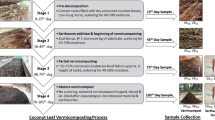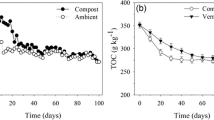Abstract
The effects of earthworms and initial substrates on the structural and functional compositions of the bacterial community in vermicomposts have been estimated by the method of denaturing gradient gel electrophoresis (DGGE) of amplified bacterial 16S rRNA gene fragments and by the kinetic method for assessing the physiological state of bacterial communities. ANOVA of the data on structural characteristics of the community (DGGE data) has demonstrated that the nature of the composted substrate has the major effect on the structure of the bacterial community. The associated variance for this factor accounts for 53% and exceeds the effect of earthworms (29%). A functional characterization of the bacterial community (data on the physiological state of bacteria as judged from their growth on different organic compounds) suggests that the presence of earthworms activates the bacterial community by increasing the variable characterizing the physiological state of bacteria (r 0). As has been shown, it is impossible to predict the effect of earthworms on the particular bacterial taxa, because the effects of similar signs (increase, decrease, or the absence of changes in all the variants) just for the three analyzed types of substrates have only been observed for 15% of the operational taxonomic units.
Similar content being viewed by others
References
B. A. Byzov, Zoomicrobial Interactions in Soil (GEOS, Moscow, 2005), [in Russian].
M. V. Gorlenko and P. A. Kozhevin, Multisubstrate Testing of Natural Microbial Communities (MAKS Press, Moscow, 2005) [in Russian].
E. A. Dmitriev, Mathematical Statistics in Soil Science (Izd. Mosk. Gos. Univ., Moscow, 1995) [in Russian].
D. G. Zvyagintsev, Soil and Microorganisms (Izd. Mosk. Gos. Univ., Moscow, 1987) [in Russian].
I. A. Zhigzhitova, Extended Abstract of Candidate’s Dissertation in Biology (Ulan-Ude, 1998).
E. N. Kubarev, N. V. Verkhovtseva, and N. V. Kuz’mina, “Microbial Cenosis of Eisenia fetida Intestines as Dependent on the Substrate, Proc. II Int. Conf. Humans and Animals, (Astrakhan’, 2005), pp. 214–215 [in Russian].
N. V. Kuz’mina, Extended Abstract of Candidate’s Dissertation in Biology (Moscow, 2005).
N. S. Panikov, Kinetics of the Growth of Microorganisms (Nauka, Moscow, 1991) [in Russian].
T. S. Perel’, Distribution Patterns of the Earthworm Fauna in the Soviet Union (Nauka, Moscow, 1979) [in Russian].
Laboratory Course on Microbiology, A. I. Netrusova (Ed.), (Akademiya, Moscow, 2005) [in Russian].
N. N. Tereshchenko, Eco-Microbiological Aspects of Vermicomposting (Izd. SO RASKhN, Novosibirsk, 2003) [in Russian].
N. N. Tereshchenko and A. B. Bubina, “Microbiological Mechanisms of the Formation of Fungistatic Properties of Vermicomposts and Vermicompost-Based Substrates,” Sib. Vestn. S.-Kh. Nauki, No. 11, 14–20 (2007).
A. V. Yakushev, Extended Abstract of Candidate’s Dissertation in Biology (Moscow State Univ., Moscow, 2009).
A. V. Yakushev, S. A. Blagodatskii, and B. A. Byzov, “The Effect of Earthworms on the Physiological State?of the Microbial Community at Vermicomposting,” Mikrobiologiya 78(4), 565–574 (2009) [Microbiology, 78 (4), 510–519 (2009)].
A. V. Yakushev and B. A. Byzov, “Hydrolase Activity as an Indicator of the State of Microbial Community in Vermicomposts,” Vestn. Mosk. Univ., Ser. 17: pochvoved., no. 2, 41–46 (2009) [Moscow Univ. Soil Sci. Bull. 62 (2), 93–98 (2009)].
A. Anastasi, G. C. Varese, and V. F. Marchisio, “Isolation and Identification of Fungal Communities in Compost and Vermicompost,” Mycologia 97(3), 33–44 (2005).
M. Aira, F. Monroy, and J. Dominguez, “Eisenia fetida (Oligochaeta, Lumbricidae) Activates Fungal Growth, Triggering Cellulose Decomposition during Vermicomposting,” Microb. Ecol. 52, 738–746 (2006).
R. Berkelmans, H. Ferris, M. Tenuta, and A. H. C. van Bruggen, “Long-Term Effects of Crop Management on Trophic Levels of Nematodes Other than Plant Parasitic Nematodes Disappear after One Year of Uniform Treatment,” Appl. Soil Ecol. 23, 223–235 (2003).
M. Gomez-Brandon, C. Lazcano, and J. Dominguez, “The Evaluation of Stability and Maturity during the Composting of Cattle Manure,” Chemosphere 70, 436–444 (2008).
C. Lazcano, M. Gomez-Brandon, and J. Dominguez, “Comparison of the Effectiveness of Composting and Vermicomposting for the Biological Stabilization of Cattle Manure,” Chemosphere 72, 1013–1019 (2008).
M. Lores, M. Gomez-Brando, D. Perez-Diaz, and J. Dominguez, “Using FAME Profiles for the Characterization of Animal Wastes and Vermicomposts,” Soil Biol. Biochem. 38, 2993–2996 (2006).
G. Masciandaro, B. Ceccanti, V. Ronchi, and C. Bauer, “Kinetic Parameters of Dehydrogenase in the Assessment of the Response of Soil to Vermicompost and Inorganic Fertilizers,” Biol. Fertil. Soils 32, 479–483 (2000).
P. Pramanik, G. K. Ghosh, P. K. Ghosal, and P. Banik, “Changes in Organic — C, N, P and K and Enzyme Activities in Vermicompost of Biodegradable Organic Wastes under Liming and Microbial Inoculants,” Biores. Technol. 98(13), 2485–2494 (2007).
B. Sen and T. S. Chandra, “Do Earthworms Affect Dynamics of Functional Response and Genetic Structure of Microbial Community in a Lab-Scale Composting System?,” Biores. Technol. 100, 804–811 (2009).
A. D. Van Diepeningen, O. J. de Vos, G. W. Korthals, and A. H. C. van Bruggen, “Effects of Organic versus Conventional Management on Chemical and Biological Parameters in Agricultural Soils,” Appl. Soil. Ecol. 31, 120–135 (2006).
A. D. Van Diepeningen, O. De Vos, V. V. Zelenev, et al., “DGGE Fragments Oscillate with or Counter to Fluctuations in Cultivable Bacteria along Wheat Roots,” Microb. Ecol. 50(4), 506–517 (2005).
I. Vaz-Moreira, M. E. Silva, C. M. Manaia, and O. C. Nunes, “Diversity of Bacterial Isolates from Commercial and Homemade Composts,” Microb. Ecol. 55, 714–722 (2008).
A. Vivas, B. Moreno, S. Garcia-Rodriguez, and E. Benitez, “Assessing the Impact of Composting and Vermicomposting on Bacterial Community Size and Structure, and Microbial Functional Diversity of an Olive-Mill Waste,” Biores. Technol. 100, 1319–1326 (2009).
M. Yasir, Z. Aslam, S. W. Kim, et al., “Bacterial Community Composition and Chitinase Gene Diversity of Vermicompost with Antifungal Activity,” Biores. Technol. 100, 4396–4403 (2009).
Author information
Authors and Affiliations
Corresponding author
Additional information
Original Russian Text © A.V. Yakushev, I.A. Bubnov, A.M. Semenov, 2011, published in Pochvovedenie, 2011, No. 10, pp. 1222–1230.
Rights and permissions
About this article
Cite this article
Yakushev, A.V., Bubnov, I.A. & Semenov, A.M. Estimation of the effects of earthworms and initial substrates on the bacterial community in vermicomposts. Eurasian Soil Sc. 44, 1117–1124 (2011). https://doi.org/10.1134/S1064229311100164
Received:
Published:
Issue Date:
DOI: https://doi.org/10.1134/S1064229311100164




